Soldiers, the Tiger is currently the most powerful and formidable German tank. As soon as it appears at the front, it causes a real panic among our soldiers. To tell you the truth, it doesn't happen that often, but if you're unlucky you must know how to approach this bastard.
Our units first encountered the Tigers in Tunisia in February 1943. Then, in the Ponte du Fahs area, well-masked British 6-pounder anti-tank guns destroyed two tanks of this type at close range. So although their debut was quite bad, after getting to know them better, our British colleagues quickly gained respect for their combat capabilities.
Tigers! Tigers!
Interestingly, for our boys, almost every angular German tank is a Tiger! Officers have a big problem with this because the soldiers at the front believe that the Germans are producing nothing but these monsters. However, this real psychosis has its justification. In certain situations, these machines have wreaked real havoc on our ranks and the British.
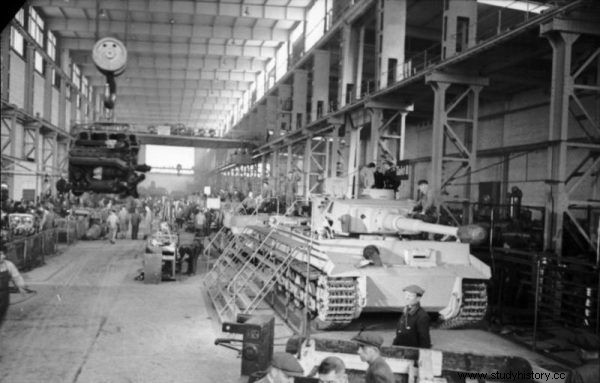
Not all tanks produced in Germany were tigers like this Panzer VI (photo:Bundesarchiv, Bild 101I-635-3965-21 / Hebenstreit / CC-BY-SA 3.0).
Tigers are a damn tough opponent, mainly due to the firing range of their 88mm cannon, powerful armor and excellent optics. Our technicians say you can spot a blade of grass through this bastard's sights up to a mile away!
The Soviets also became convinced of the high efficiency and vitality of the Tiger on the battlefield. A good example is one of the cars of the German 503rd Heavy Tank Battalion fighting near Rostov in January 1943. It received 227 hits from anti-tank guns, 14 hits from 45-57 mm guns and 11 hits from 76 mm guns, and yet stayed in action!
The Soviets, however, learned from this lesson. They retrofitted the T-34 with more effective cannons and introduced new types of heavy tanks and armored guns to their weapons. We and the British have virtually nothing to compete effectively with the Tigers. I don't want to scare you, but these are the facts.
Sherman vs Tiger
Despite the obvious advantages, the Tiger has some disadvantages: is terribly slow and not very maneuverable . In the field, its maximum speed is only about 20 km / h. The rotation mechanism of its turret is also poor, as it moves slowly with jerks. Its full rotation takes from 25 seconds to even a minute.
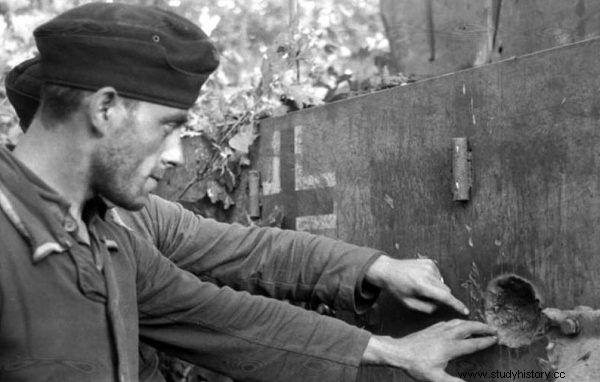
For Sherman crews, many hits on the Tiger ended like this:no penetration (Bundesarchiv, Bild 101I-022-2935-24 / Wolff / Altvater / CC-BY-SA 3.0).
You know very well that in our Sherman, the same thing only takes 10 seconds. When seconds are decisive for life and death, take advantage of every advantage. Thanks to the higher speed you will be able to fire 4-5 shots with impunity before the Tiger can react. And remember, it's best to aim for the rump where it has the weakest armor.
Never attempt a frontal duel with Sherman with this colossus. At a distance of 1000 meters, the shells used on our seventy-five can penetrate armor only 62 millimeters thick. The new 76mm cannon does little to improve the situation. The performance has increased, but we have a very limited number of sub-caliber armor-piercing shells for it, quite good indeed.
Sometimes, however, this is not enough to overcome the 100-millimeter frontal hull and tiger turret armor at greater distances. On the other hand, the British, when testing the captured tank of this type, found that the shell of its cannon is capable of destroying the Sherman from a distance of 2500 m.
War luck also counts
I am sensitizing you, it is best to shoot the Tiger from an ambush, from the shortest possible distance. Otherwise, you can only count on a miracle . And because in war, as in war, miracles sometimes happen, sometimes the Tiger is destroyed in an unconventional way. Two such situations are mentioned by Antony Beevor in the book "Ardennes 1944".
During the German offensive on the road near Schönberg, the American M8 Greyhound armored car crept up to the Tiger from behind:
and opened fire with his tiny 37mm cannon . The tank commander tried to turn the turret towards the attacker, but the Greyhound crew managed to get 25 meters to the target and send three missiles to the poorly protected rear part of the tank. "We heard a muffled sound of an explosion, and a moment later we saw fire puffing from the tower and engine."
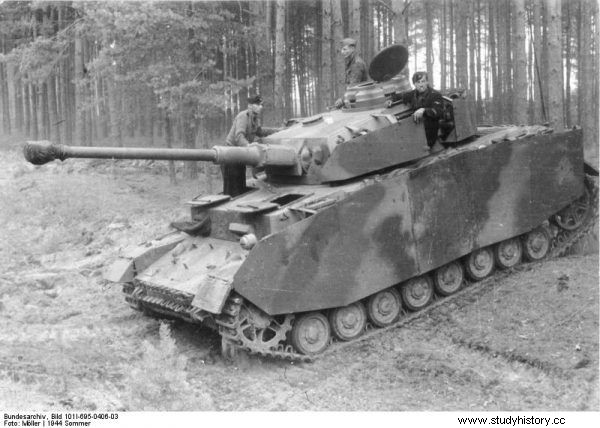
American soldiers often confused PzKpfw IV with Tigers (photo Bundesarchiv, Bild 101I-695-0406-03 / Möller / CC-BY-SA 3.0).
Another interesting event happened during the fights for Rocherath-Krinkelt. The crew of one of the Shermans of the 741 Tank Battalion noticed that the Tiger was riding straight on them. The American commander realized that he had no chance in a leading one-on-one fight, so he decided to use the advantages of his machine. Antony Beevor describes it like this:
The tank quickly turned and circled, hiding behind nearby buildings, wanting to be able to shoot the side or back of the "Tiger". At the same time, however, the Germans saw through the enemy's intentions and after a while both tanks began to chase each other in a circle, trying to take the most advantageous position to fire.
All this was watched by the crew of the second Sherman, who waited for the Tiger to face them, then fired an accurate shot at the enemy vehicle. " The commanders of both American tanks jumped outside to shake hands elated, then climbed back into their machines and went back to work.
By the way, we are not entirely sure if our tankers actually dealt with Tigers in both cases. Perhaps it was just their imagination, and they fired at smaller but very similar PzKpfw IV.
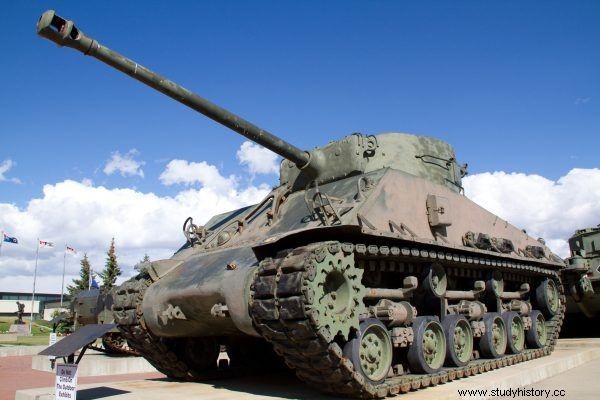
How many Shermans does it take to destroy a Tiger? It depends (Photo:Tony Hisgett, CC BY 2.0).
The Tiger's greatest enemy:Piper Cub
If, however, everything has already failed, call in assault aviation or heavy artillery before you shit your pants. They will do the job for you. And remember to regularly sell the whiskey to the pilots from the Piper Cub observation teams. In difficult times, they will be your guardian angels.
We also use smoke screens on a large scale, which effectively hinder the actions of the German armies. This happened, inter alia, during the fighting near Caen in July 1944. Tigers from the 102nd SS Heavy Tank Battalion operated there, participating in the fierce battles for hill 112, which was a key position in that area.
On July 9, fourteen Tigers of the 1st company of the 102nd battalion, supported by panzer grenadiers, struck this hill for the first time. There, German tanks clashed with the Churchills of the 31st Armored Brigade. When the Germans started decimating British tanks , bombing fighters attacked them. Smoke grenades began to explode between the Tigers as well, and soon the whole area was shrouded in a thick fog. The Germans, who had not known this way of fighting so far, retreated confused.
The situation repeated itself over the next days. As soon as the Germans set off, our air force, guided by small Piper Cub observation planes, entered the action, and the artillery put up a smoke screen. This often led to chaos in the ranks of the German tanks, it even happened that during one of the actions two Tigers fired at each other. July 11 commander of the 3rd company of the 102nd battalion, SS - Untersturmführer Klust, even refused to attack the British positions in the thick smokescreen. He was, however, stripped of the command.
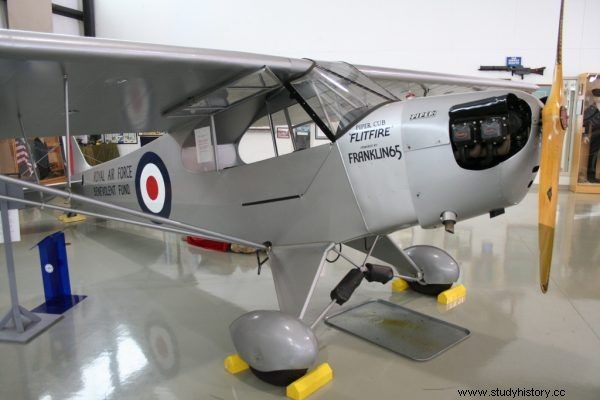
Piper J-3 Cub used previously by the RAF (photo:RadioFan at English Wikipedia, CC BY-SA 3.0).
In total during the fighting in Normandy, between July 9 and August 30, 1944, the 102nd SS Heavy Tank Battalion lost all of its 45 Tigers . The Nazis reported the destruction of 227 Allied tanks, 28 armored guns and a significant number of other light armored vehicles and enemy vehicles. The price for destroying the Tigers was therefore very high.
Duel of the giants
If you've been a little scared, now I'll cheer you up. Several new tanks have already arrived at our units. So far, they have had no counterpart in our armored forces. The English also have nothing of the sort. This is the M26 Pershing. Its frontal armor is 102 mm thick and it is armed with a 90 mm gun. He had even taken part in two skirmishes with the Tigers. So far the result is 1-1.
In the evening of February 26, 1945, Pershing, own name Fireball, from the "F" company of the 1st Battalion of the 33rd Panzer Regiment, occupied a blocking position on the exit road from the town of Elsdorf. After dark, illuminated by numerous fires, the tank was hit three times by the PzKpfw VI Tiger Ausf. E from the Heavy Tank Company "Hummel" from a distance of just 90 meters.
The first German missile passed through the machine gun hole in the turret and exploded inside, killing the gunner and loader . The second hit the muzzle brake of the gun, detonating a projectile inside the bolt. The third ricocheted off the turret armor. The Tiger tried to retreat after his success, but was stuck in the ruins after a while and was abandoned by the crew. Fireball, on the other hand, was renovated and returned to the fight again.
The next day, Pershingas played against the Germans. In the same area, our Shermans fell under the fire of another Tiger from the "Hummel" company. Pershing, led by Sergeant Nick Mashlonik, was sent to support them.
Upon arriving at the scene, the guys found that the case was bad because the Tiger was entrenched, making it a much more difficult target. At one point, however, the German tank began to leave its shelter. Our people were not surprised and from a distance of about a thousand meters they opened fire . Mashlonik recalls:
When it briefly exposed its bottom, I immediately opened fire and hit it. Another missile tore off its right track. The third shell - fragmentation - hit the turret, killing the evacuating crew .
I would like to add that Mashlonik destroyed two accompanying PzKpfw IV, and the next day another PzKpfw IV. So you admit that our M26's combat debut was quite promising.
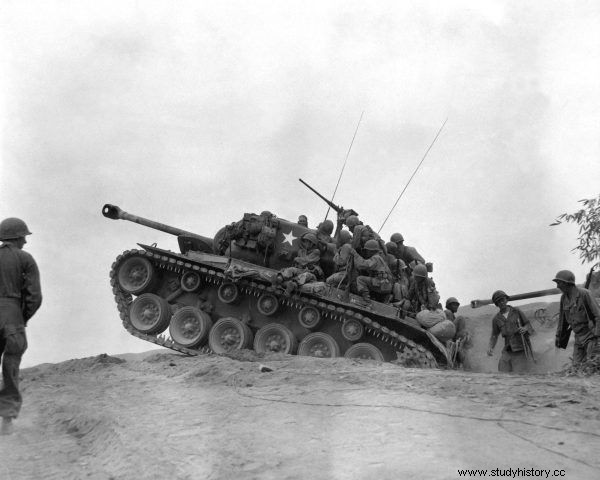
M-26 Pershing in 1950 (photo by Thomas Marotta, National Archives and Records Administration collection, public domain).
The most dangerous tank of World War II
There is really no effective way to deal with Tigers. It is true that we have combat vehicles that can attempt to fight them, but only under favorable circumstances. Apart from the Pershing, this applies especially to the M18 Hellcat tank destroyers armed with 76.2 mm guns and the M36 Jackson tanks equipped with a 90 mm gun. The Sherman Firefly version with its excellent 17lb cannon also has a chance.
At the end of December 1944, new British A34 Comet tanks also arrived at the front. Nevertheless, the surest way to destroy the German monster is to support assault aviation or heavy artillery. So think again about everything that I wrote about. Good luck and happy hunting, gentlemen!
